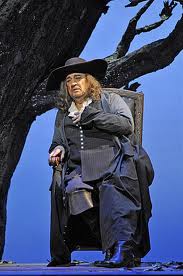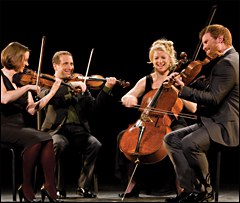 Speaking of brilliant stage performers who aren’t spring chickens anymore and yet hardly ready to screw the lids on their pots of greasepaint — as I recently did on this blog of Chita Rivera — Placido Domingo, who will shortly turn 70, shows very few signs of letting up.
Speaking of brilliant stage performers who aren’t spring chickens anymore and yet hardly ready to screw the lids on their pots of greasepaint — as I recently did on this blog of Chita Rivera — Placido Domingo, who will shortly turn 70, shows very few signs of letting up.
As the title character in Franco Alfano’s Cyrano de Bergerac, which is currently being produced at the San Francisco Opera, the great Spanish singer holds the audience in thrall. His voice is full fills the sizable War Memorial auditorium effortlessly. He is as comfortable bellowing war cries at the bottom of his register as he is hitting the high notes while singing about romance. Even under the weight of his floppy, feathered hat and prosthetic nose, Domingo manages to exude a virile presence. At 69, he is equally capable of embodying youth in the throes of ecstasy, as he is a sick, old man lamenting lost love at the end of the story.
Domingo doesn’t move around a great deal on stage. During the sword fights, other people move around him but he stays fairly still. This conceit works quite well from the point of you of conveying a sense of the character’s effortless power over his enemies. But it also gives the game away slightly: Domingo has a great deal of energy. But he’s perhaps not going to dart around the stage with a sword as much today as he might have done in years past.
If only the opera itself were more worthy of its star. There’s a reason why Alfano’s Cyrano isn’t performed very often: Musically, it’s fairly inert, with few remarkable instrumental passages and no memorable arias. It takes a performer of the caliber and reputation of Domingo to bring it to the stage and keep us glued to our seats.
On another completely unrelated note: The School of the Arts in San Francisco, a fabulous and terribly under-funded public school which produces many fine young performers, is planning to undertake a tour with its choral ensemble to Chicago in 2011. The choir will be participating in master classes with renowned choral conductors and professional singers as well as presenting several free public concert collaborations with celebrated Chicago choirs. To raise the $75,000 necessary to send the students to the mid-west, SOTA is undertaking a big fundraising campaign. The school is selling CDs and greetings cards online. To find out how to donate to a worthy cause, please click here. “It’s a fantastic educational opportunity to build our repertoire and grow as artists,” says the head of SOTA’s choral program, Todd Wedge, about the upcoming tour. “Please help us realize our dreams.”

 Journalists love interviewing people who don’t toe the party line, but give an opposing view on a subject. A detractor’s opinions provide that all-important bit of tension in a story that makes it more fully rounded and readable. This opposing viewpoint is particularly important (but hard to come by) in arts journalism, where most interviewees — not to mention the reporters themselves — tend to spend their time talking about how great an artist’s work is and how excited they are about it. This is why so much arts journalism is bland and expendable.
Journalists love interviewing people who don’t toe the party line, but give an opposing view on a subject. A detractor’s opinions provide that all-important bit of tension in a story that makes it more fully rounded and readable. This opposing viewpoint is particularly important (but hard to come by) in arts journalism, where most interviewees — not to mention the reporters themselves — tend to spend their time talking about how great an artist’s work is and how excited they are about it. This is why so much arts journalism is bland and expendable. The newly-reopened Venetian Room at the Fairmont Hotel was completely packed for Friday evening’s one-night-only performance by Broadway icon Chita Rivera.
The newly-reopened Venetian Room at the Fairmont Hotel was completely packed for Friday evening’s one-night-only performance by Broadway icon Chita Rivera.  It’s always exciting when a new cultural space opens up in a city, especially in tough economic times.
It’s always exciting when a new cultural space opens up in a city, especially in tough economic times. Is it a good thing or a bad thing that normal concert etiquette goes out of the window for lunchtime and commuter hour concerts?
Is it a good thing or a bad thing that normal concert etiquette goes out of the window for lunchtime and commuter hour concerts? It’s been hard to avoid baseball in San Francisco lately. Last night in particular was a symphony of blaring car horns and shrieking, gimme-five-slapping pedestrians as citizens made their excitement about the home team’s victory over the Texas Rangers strongly felt.
It’s been hard to avoid baseball in San Francisco lately. Last night in particular was a symphony of blaring car horns and shrieking, gimme-five-slapping pedestrians as citizens made their excitement about the home team’s victory over the Texas Rangers strongly felt.